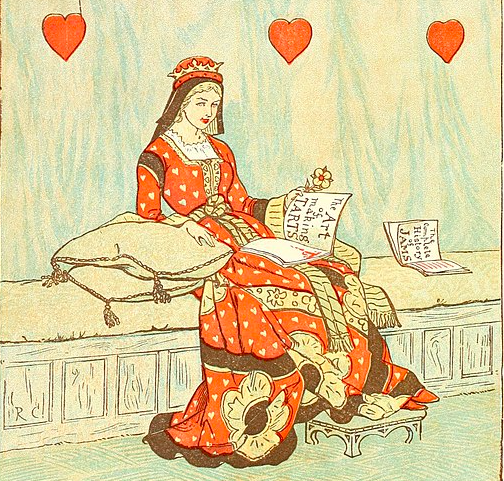It was the summer of 1980.
Grandma and Grandpa drove cross-country to our house in Minnesota from Washington, in the “Jamboree” motor home. Parked on the driveway for two weeks, my sister and I reveled in the mini-house on wheels, which became a daydream of playing barbies up in the lofted bed area or coloring our hearts out, at the small fold-out table in the “kitchen.”
At the beginning of my grandparent’s visit, we had no way of knowing my sister and I were going to be learning a life-long skill: cribbage, won over by the Queen of Hearts.
Grandpa was a wiz at playing the game, and his teaching method was solid, patient, and kind. Soon enough, “15-2, 15-2, and a pair for six” became the norm from nine in the morning until well into the afternoon. My sister and I delighted in my grandpa’s presence, the songs he taught us from his own childhood, and the snacks were plentiful.
We never tired of the game, as we hoped for the cards to bring us the most luck to jump the pegs and holes on the board to winner status. It was a marvelous two weeks, with prized time and attention from grandpa, and I was genuinely happy. As I grew up, I continued to cherish those precious memories of never-ending cribbage games in the motor home with grandpa and exuding the warm feeling of happiness.
Flash-forward 40 years, as an adult, trying to recreate cribbage-games-only-grandpa-can-bring-happiness. Every day. Learning to create happiness is a personal choice and responsibility, as nobody else can generate the happiness we desire.
Sure, we can feel that gooey-candy feeling and filled up around certain individuals or particular experiences bring happiness, however, happiness is created by us, for us. It’s our influence, how we direct ourselves and choices, which allows greater latitude for cultivating happiness.
We know the feeling of happiness. The warmth of feeling happy and joyful as it permeates through our cells and our hearts, when we’ve made someone else’s day, accomplished a major goal, played with our pet, created something, or spent quality time with friends and family who enrich our lives.
The heart has its own electromagnetic field and is 100 times greater than the strength of the brain energy field. Our heart energy can be detected up to three feet away and is felt by others—especially when we’re truly happy.
“I have decided to be happy because it is good for my health.” ~ Voltaire
Through my own personal experience of embarking on a happiness journey and using my trusty inner heart compass, I’ve found the following to be of value in cultivating lasting effects of happiness:
1. Self-care is essential.
Begin with something tangible and relatively easy to incorporate into your day. Spending even five minutes of quiet meditation and/or journaling every morning will bring about the lasting changes of happiness. Giving gratitude for the people in our life and things we already have creates happiness and ushers in more gifts.
Self-care is learning to listen to our mind-body and honoring what it requires. Sometimes, taking an Epsom salt bath is the perfect remedy, while other times, taking a car ride to take in the fall foliage does the trick. Listening to preferred music or frequencies, such as Binaural Beats or Solfeggio frequencies, will facilitate changing the neural structure in the brain, creating more happy hormones.
Letting go of certain habits or people, while trading low-vibration emotions of anger, pride, and sadness for high-vibration emotions of joy, appreciation, and peace is another form of self-care. We are making a statement of “I care enough about myself to feel happy.”
2. Maintain hobbies, creative outlets, and play.
We have the tendency to become wrapped up in spending our whole day living in a mental fog, acting on autopilot. When we carve out time to engage in creative outlets, it frees up the brain. We become increasingly alert-oriented, improve our confidence and decision-making skills, mental clarity, decrease anxiety, and cultivate happiness.
Creative outlets and hobbies can be quite varied. If you’re searching for something to fill a void, spend some time in dreamy, childhood reflection. What were the things and activities that brought us happiness and contentment? Many times, those lost or forgotten skills are door openers for favorite occupations. When we were kids, one of our main occupations was to play. As adults, the importance of integrating play into our lives is imperative for alleviating stress and adding to our happiness cup.
3. Be of service.
When we give to others, we also receive happiness through the heart. If we enjoy volunteering or heading up a committee within the community, we’re acting in service. According to a study in BMC Public Health, the conclusion illustrates volunteer work significantly increases mental and physical well-being. Mental health, physical health, life satisfaction, and social well-being were positively correlated, and they were negatively correlated with depression.
Likewise, service to others is how we present and show up in our careers. We’re in a role for a particular reason; embracing our gifts and what we offer colleagues or clients. Learn to appreciate the give and receipt of the service, knowing benefit and worth are being traded for value and appreciation. When we show up in life, are willing to be of service to the best of our ability, and give gratitude for being able to be of service, we create more happiness for ourselves.
4. Dump and befriend trauma.
This area may span a range for individuals, depending on how extensive the trauma is and our family system dynamics. While I do know clearing trauma takes diligence, intention, time, and self-love, it’s worth it beyond measure. How we go about doing this heavy work is a personal choice.
Trauma changes our brains, and many individuals have extreme difficulty finding happiness or feeling worthy enough to be happy. They often ask themselves, “Do I even deserve to be happy?” Yes, we do! The more layers of old patterns and experiences we clear, the lighter and happier we become. Our inner dialogue begins to shift from negative to positive.
We all know the body is continuously responding to our inner dialogue, whether it’s conscious or unconscious, so finding ways to retrain the neural pathways for positivity is important.
Additionally, as we continue to rid the brain-body of trauma, we open new doors to ideas and passions we were too afraid to follow before or wasn’t on our radar. More often than not, these new beginnings create more happiness that lasts.
5. Body movement.
Moving our body has multiple benefits. Not only does it increase serotonin and endorphin levels in the brain, which creates happiness, it moves stagnant energy through, which also means moving negative experiences and stress out of the body. It’s a double win; now we’re happier because of the brain chemical boost, and happier as we’re ridding the brain-body of stress. Body movement is any traditional exercise (run, walk, ski, bike, swim), yoga, sex, tai chi, gardening, painting, or even hula hooping.
Appreciating the gift of being able to move is another way to give gratitude for our bodies while treating it with respect and kindness. When we move our joints and muscles, we activate the proprioceptors, which exerts an overall calming effect on the body. Calm feels good, creating happiness.
6. “This is your dance space, this is mine.”
Remember that line in “Dirty Dancing”? Having clear boundaries and personal space enhances our happiness. We know the feeling when we’ve said “yes” to something we really didn’t want to do, or allowed someone to walk all over us. It doesn’t feel good and we know it. When we take care to understand ourselves, we can develop new boundaries that are aligned with our current mind-body-spirit self. We then show another person where the line in the sand is drawn.
Personal space is significant for allowing the quiet space to rejuvenate and settle into our thoughts and body, as well as time away from other people. Too much noise dulls the senses and is a distraction from introspection. Learning to acknowledge our own presence as our “best friend” and the quiet as a sacred time for refueling, will reap benefits.
Happiness falls within a range; it may have taken us years to realize we’re the creators of our lives and our happiness. When we’re aligned and happy within, we continue to maintain a uniformed level of happiness, even when big stressors knock us off our feet or our world seems to be crashing down around us. We demonstrate increased resiliency and grit, armed with happiness and gratitude, which propels us through challenging situations.
What appealed to us as children and adolescents most likely don’t captivate us as adults. Occupations and interests change or are further cultivated with aging. We continue to heal, adapt, change, and explore, which calibrates us internally in mind-body-spirt, and fills our happiness cup.
At any point, I could pick up and engage in a rousing game of Cribbage, but it’s not the same without grandpa here to play. At least I learned to become the queen of my own heart.
~
Reference:
Zhang, Z., Yeung, J., and Kim, T. September 22, 2017. “Volunteering and Health Benefits in General Adults: Cumulative effects and Forms”. BMC Public Health, 2017. 17: 736.
~


 Share on bsky
Share on bsky





Read 6 comments and reply